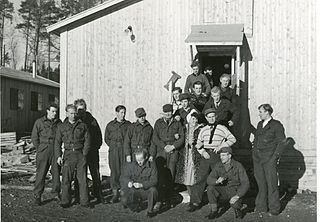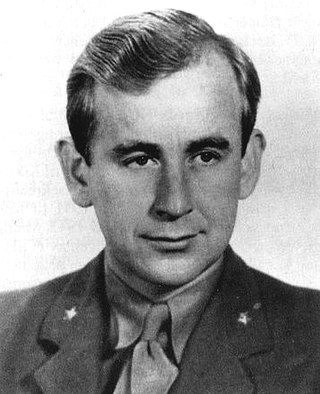
The Norwegian resistance to the occupation of Norway by Nazi Germany began after Operation Weserübung in 1940 and ended in 1945. It took several forms:

The Norwegian heavy water sabotage was a series of Allied-led efforts to halt German heavy water production via hydroelectric plants in Nazi Germany-occupied Norway during World War II, involving both Norwegian commandos and Allied bombing raids. During the war, the Allies sought to inhibit the German development of nuclear weapons with the removal of heavy water and the destruction of heavy-water production plants. The Norwegian heavy water sabotage was aimed at the 60 MW Vemork power station at the Rjukan waterfall in Telemark.
Milorg was the main Norwegian resistance movement during World War II. Resistance work included intelligence gathering, sabotage, supply-missions, raids, espionage, transport of goods imported to the country, release of Norwegian prisoners and escort for citizens fleeing the border to neutral Sweden.
Norwegian Independent Company 1 was a British Special Operations Executive (SOE) group formed in March 1941 originally for the purpose of performing commando raids during the occupation of Norway by Nazi Germany. Organized under the leadership of Captain Martin Linge, it soon became a pool of talent for a variety of special operations in Norway.
A limpet mine is a type of naval mine attached to a target by magnets. It is so named because of its superficial similarity to the shape of the limpet, a type of sea snail that clings tightly to rocks or other hard surfaces.
The Osvald Group was a Norwegian organisation that was the most active World War II resistance group in Norway from 1941 to the summer of 1944. Numbering more than 200 members, it committed at least 110 acts of sabotage against Nazi occupying forces and the collaborationist government of Vidkun Quisling. The organisation is perhaps best known for conducting the first act of resistance against the German occupation of Norway, when on 2 February 1942, it detonated a bomb at Oslo East Station in protest against Quisling's inauguration as Minister-President.

Gregers Winther Wulfsberg Gram was a Norwegian resistance fighter and saboteur. A corporal and later second lieutenant in the Norwegian Independent Company 1 during the Second World War, he was killed in 1944.

Jens-Anton Poulsson DSO, was a Norwegian military officer. During World War II he was a Norwegian resistance member, especially noted for his role in the heavy water sabotage 1942–1943. He continued his military career after the war, and was appointed colonel in 1968.
RMO was a Norwegian clandestine organization for naval intelligence during World War II, led from Oslo. The organization operated from Spring 1942 until the end of the war in the spring of 1945.
Ragnar Leif Ulstein MM was a Norwegian journalist, writer and resistance member. He wrote several documentary books from the Second World War, including surveys of the SOE group Norwegian Independent Company 1, volunteers sailing from Norway to Scotland, refugee traffic from Norway to Sweden, and military intelligence in Norway.
Roy Nielsen was a Norwegian resistance member during World War II, a member of Milorg and involved in propaganda and sabotage. Among his sabotage operations was the destruction of 25 Messerschmitt fighter aircraft and 150 engines stored in a bus garage in Oslo, on 14 August 1944, together with Max Manus, Gunnar Sønsteby and others. Together with Max Manus he succeeded in sinking the German troop ship SS Donau in the Oslofjord 16 January 1945, by placing magnetic limpet mines with time delay on the ship's side.
Oslogjengen was a sabotage group operating in Oslo from May 1944 to May 1945, during the last year of the occupation of Norway by Nazi Germany. The group had its basis in both the British Special Operations Executive and the Norwegian Milorg, was coordinated by Gunnar Sønsteby, and had around ten members. It was the dominant sabotage group in Oslo between May and September 1944, when they performed a series of successful sabotage operations.
Arne Kjelstrup, MM was a Norwegian resistance member during World War II, especially noted for his role in the heavy water sabotage 1942–1943, and for being military leader of Milorg section D-161 (Kongsberg/Numedal) during the anti-demolition operation Sunshine 1944–1945.
Operation Sunshine was an anti-demolition operation in occupied Norway from October 1944 to May 1945. It was planned by Norwegian military personnel in the United Kingdom in cooperation with British forces, and part of an effort to protect essential installations and industry, in particular large power stations, against destruction in a possible scorched earth action by the Germans towards the end of World War II.

Operation Leader was an air attack conducted against German shipping in the vicinity of Bodø, Norway, on 4 October 1943, during World War II. The raid was executed by aircraft flying from the United States Navy aircraft carrier USS Ranger, which was attached to the British Home Fleet. The American airmen located many German and Norwegian ships in this area, destroyed five and are believed to have damaged another seven. Two German aircraft searching for the Allied fleet were shot down. Three American aircraft were destroyed in combat during the operation, and another crashed while landing.

The Norwegian police troops in Sweden during World War II consisted of around 15,000 men, recruited from Norwegian refugees and trained at a number of secret camps in Sweden.

Operation Mardonius was a military operation directed against German ships in occupied Norway, planned and carried out in 1943 by the British Special Operations Executive (SOE). The outcome of the operation was sinking of two ships in the harbour of Oslo, Ortelsburg of Hamburg and Tugela.
Hans "Kyllingen" Storhaug, MM, DSM was a Norwegian resistance member during World War II, especially noted for his role in the heavy water sabotage 1942–1943, and for his participation in the SOE operation Grebe and Grebe Red in Østerdalen 1943–1945.
Birger Rasmussen MC & Bar was a Norwegian businessman, director of Katfos Fabriker, manager of Borregaard's pulp and paper section, director of Follum Fabrikker, and president of the Federation of Norwegian Industries.
Operation Kestral was a World War II mission conducted by a branch of the British Special Operations Executive (SOE) called Company Linge, which was a Norwegian group. The operation aimed to sabotage production at the Fosdalen iron ore mines.






